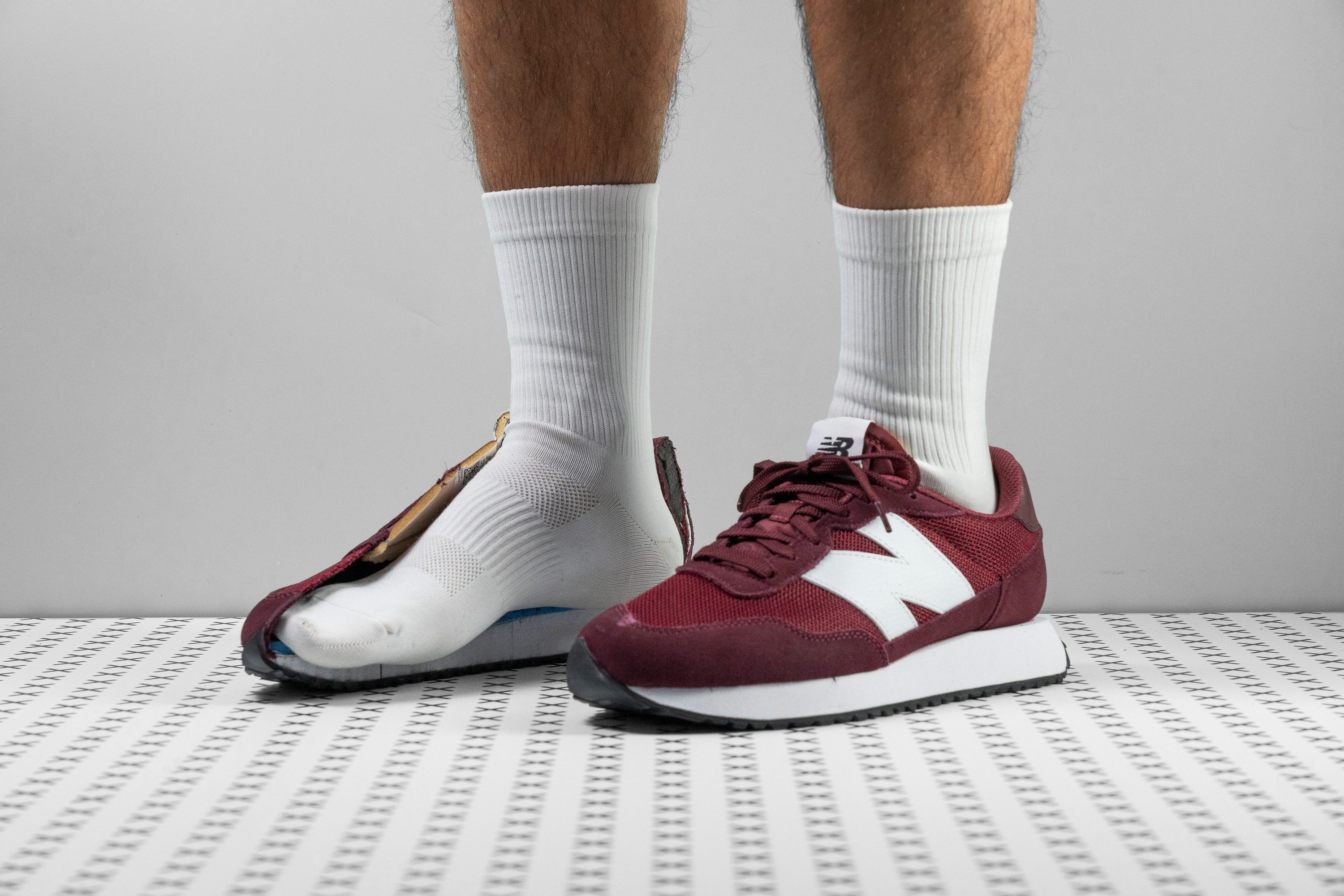Our verdict
- Top pick in best New Balance trainers
- Top pick in best breathable trainers
Pros
- Super affordable
- Very durable materials
- Breathable and ready for the summer
- Out-of-box comfortable
- Impressive traction on dry and wet
- Retro vibes and effortlessly chic
- Mix-and-match queens
- Loads of colorways
- Compliment magnet
- Super affordable
- Impressive traction on dry and wet
Cons
- Firm dead-feeling sole
- Materials wrinkle
- Materials wrinkle
Audience verdict
Comparison
The most similar trainers compared
+ + Add a shoe | |||||
|---|---|---|---|---|---|
| Audience score | 90 Good! | 96 Superb! | 90 Good! | 90 Good! | |
| Price | £90 | £155 | £75 | £110 | |
| Style | RetroSporty | Sporty | ClassicDadSporty | RetroSporty | |
| Shock absorption | High | Moderate | Moderate | High | |
| Energy return | Low | Moderate | Low | Moderate | |
| Traction | High | High | High | High | |
| Breathability | Breathable | Breathable | Moderate | Breathable | |
| Weight lab | 11.3 oz / 319g | 13.2 oz / 373g | 13.9 oz / 393g | 10.6 oz / 301g | |
| Size | True to size | True to size | True to size | True to size | |
| Midsole softness | Firm | Firm | Firm | Balanced | |
| Material | MeshSuede | MeshSuede | Suede | MeshSuede | |
| Season | SpringFall | Summer | SpringFall | SpringFall | |
| Inspired from | Running | Running | Running | Running | |
| Width / fit | Medium | Medium | Narrow | Medium | |
| Toebox width | Medium | Medium | Wide | Medium | |
| Leather/suede quality | Real suede | Real suede | Real suede | Real suede | |
| Toebox durability | Decent | Bad | Decent | Decent | |
| Heel padding durability | Bad | Bad | Decent | Bad | |
| Outsole durability | Good | Bad | Good | Good | |
| Heel stack lab | 35.2 mm | 34.8 mm | 38.2 mm | 35.0 mm | |
| Stiffness | Moderate | Stiff | Moderate | Moderate | |
| Tongue padding | Thin | Average | Thin | Very thin | |
| Drop lab | 10 mm | 10 mm | 13 mm | 10 mm | |
| Forefoot | 25.2 mm | 24.8 mm | 25.2 mm | 25.0 mm | |
| Removable insole | ✓ | ✓ | ✓ | ✓ | |
| Heel tab | None | None | None | None | |
| Torsional rigidity | Moderate | Moderate | Moderate | Moderate | |
| Heel counter stiffness | Moderate | Stiff | Moderate | Moderate | |
| Closure | Laces | Laces | Laces | Laces | |
| Top | Low top | Low top | Low top | Low top | |
| Ranking | #75 Bottom 38% | #4 Top 4% | #71 Bottom 41% | #64 Bottom 47% | |
| Popularity | #55 Top 46% | #14 Top 12% | #6 Top 5% | #9 Top 8% |
Who should buy
Don't let this former running shoe run away if you're looking for:
- A retro, cool pair that makes everything in your wardrobe stylish.
- A breathable shoe with a minimalistic design for your summer walks around town.
- An affordable and versatile companion for your daily life.
- Some lightweight but durable kicks made with authentic materials.

Who should not buy
If you are into cloudy, spongy, fluffy, plushy shoes, you're not gonna like this one. It has a firm sole, so your feet won't feel like they're stepping on cotton candy. If you don't want to change brands and you're looking for a super comfortable pair for all-day wear to rock in the summer, we believe you should go for the New Balance 1906R. If you're on a budget, the New Balance 327 is another great choice, and it comes in multiple colours!
Additionally, we don't think this model would be the best choice for the sneakerheads with foot conditions. Even though everybody knows New Balance excels at arch support, we'd recommend a more supportive pair with a better lockdown. The New Balance XC72 might just be what you're looking for.
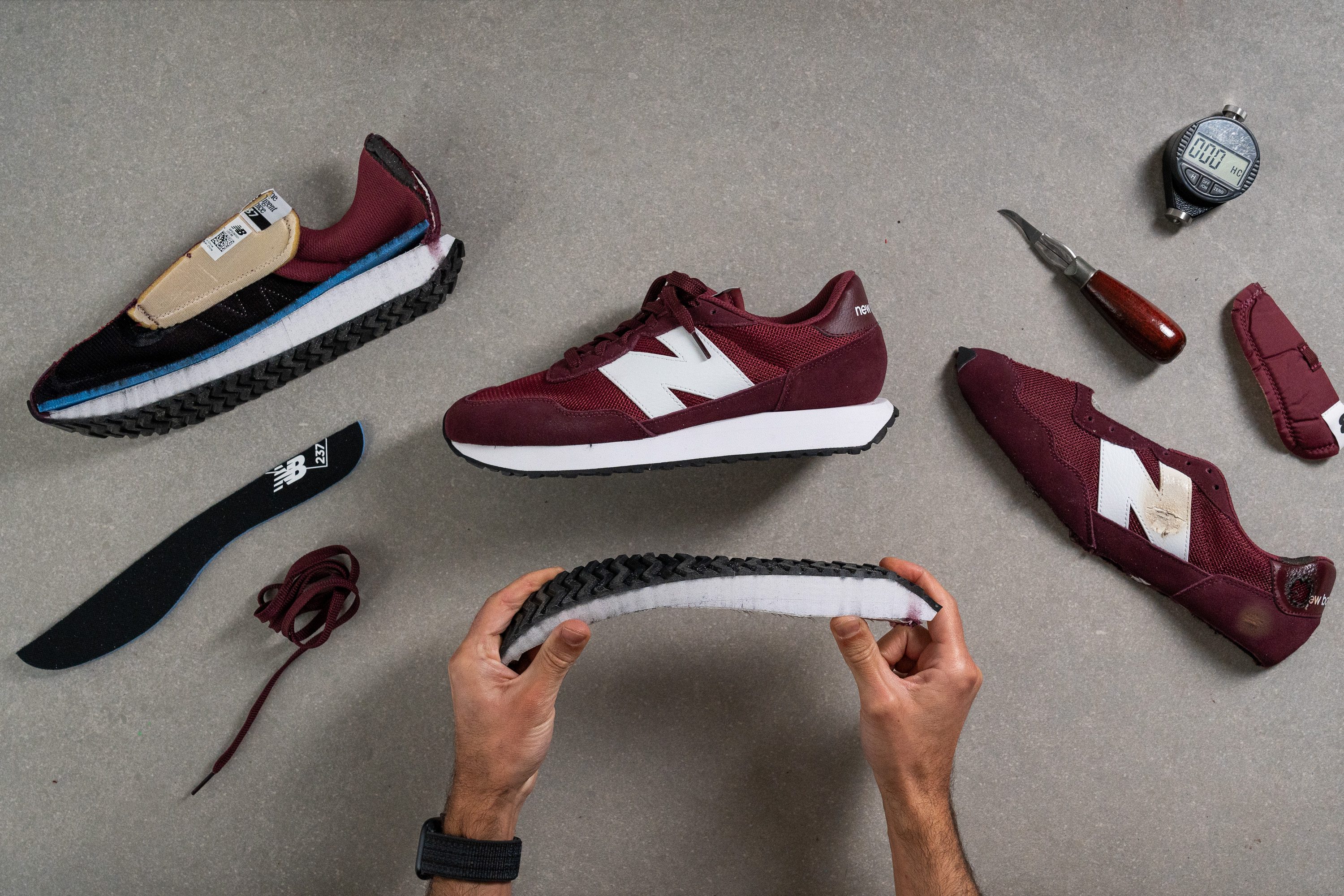
Cushioning
Shock absorption
New Balance uses a thick slab of dense EVA foam for the NB 237's midsole. It may not sound very exciting, but our test revealed that it offers excellent shock absorption for a casual sneaker.
With an above-average reading of 109 SA, this blend absorbs a major portion of the impact, reducing the load on our feet, ankles, knees, and hips. It was a pleasant surprise given the shoe's very low price point.
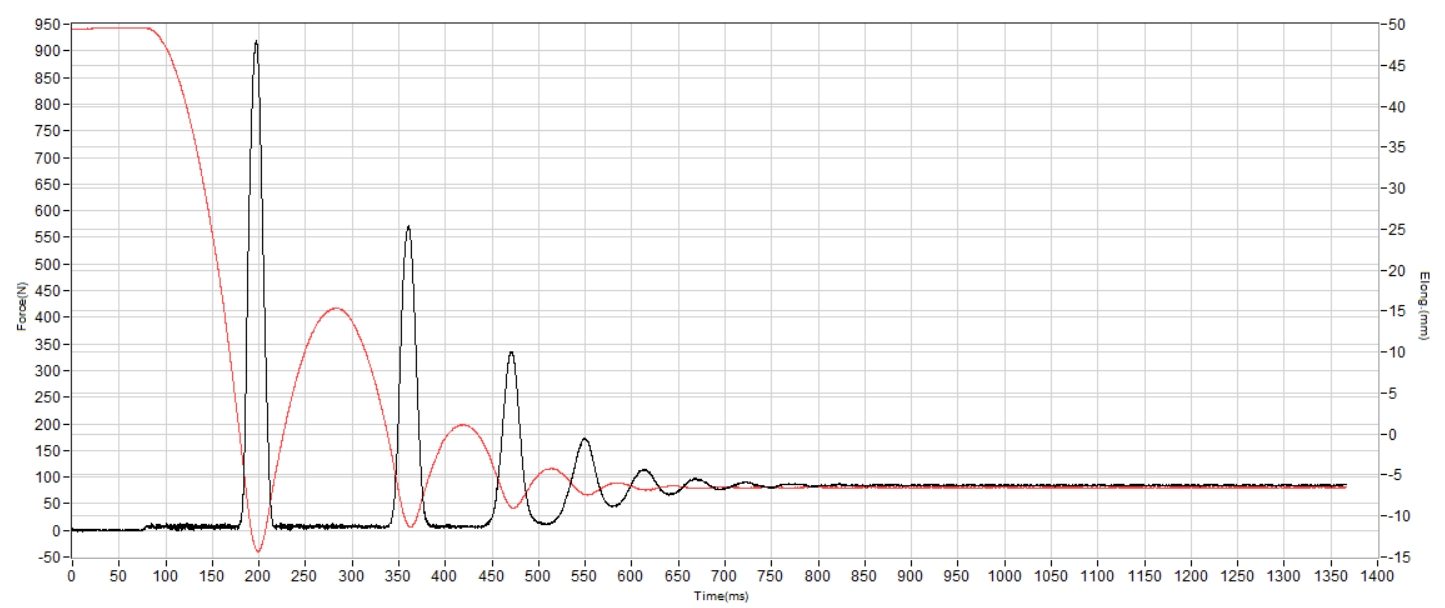
| 237 | 109 SA |
| Average | 89 SA |
Energy return
On the downside, this New Balance shoe feels pretty dead underfoot.
With a low energy return of only 42%, there is no liveliness or pep in the 237's sole. But it does feel stable as there in no compression to cause the wobbles.
| 237 | 41.6% |
| Average | 50.2% |
Heel stack
With an above-average heel stack of 35.2 mm, this New Balance shoe makes sure our feet are very well protected from the ground.

| 237 | 35.2 mm |
| Average | 30.7 mm |
Forefoot stack
The forefoot stack is also higher than average at 25.2 mm. Not too high to completely mute the ground feel, but high enough to offer extra care for our toe joints and the ball of the foot.
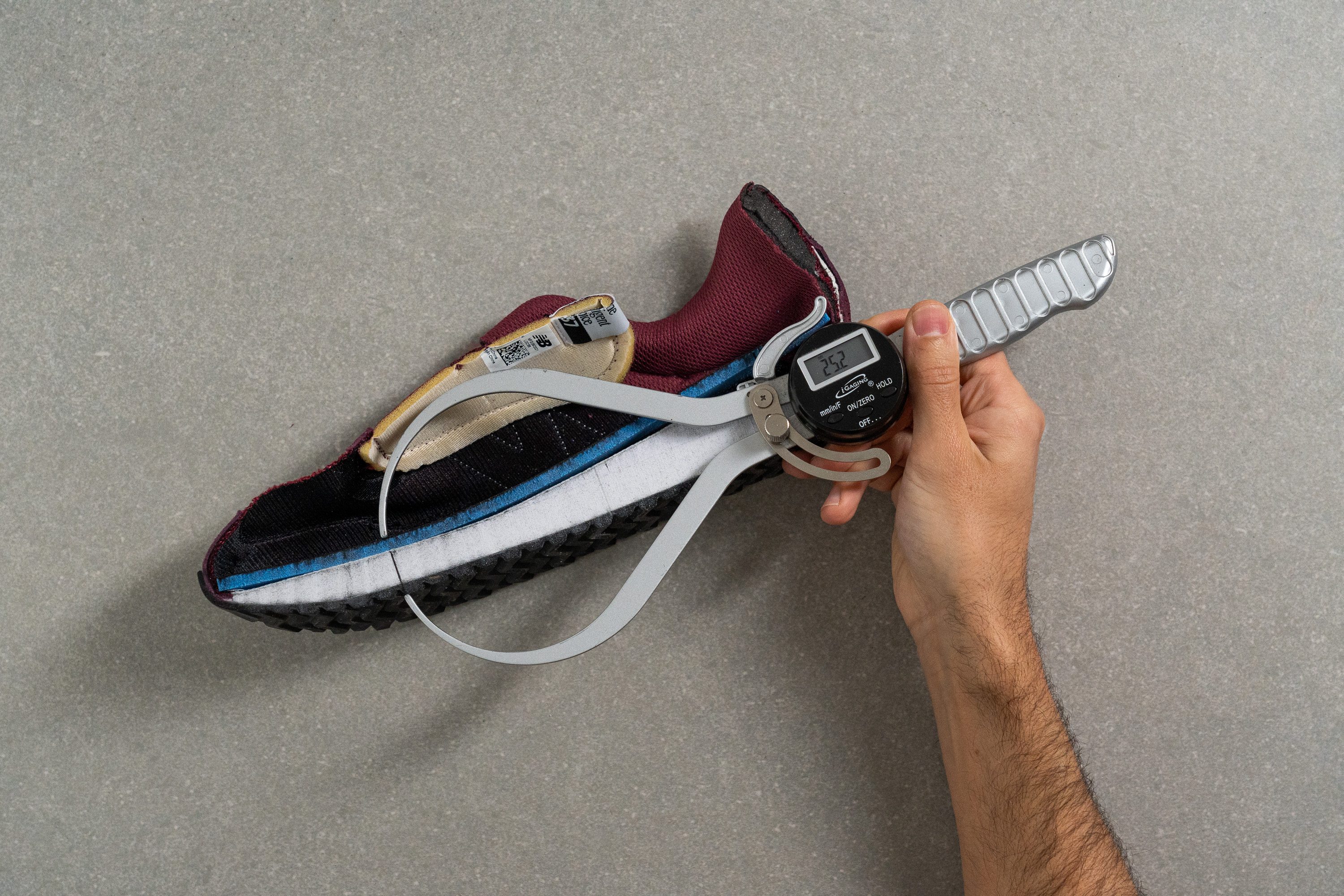
| 237 | 25.2 mm |
| Average | 19.5 mm |
Drop
At 10.0 mm, the shoe's heel-to-toe drop proved to be just average.
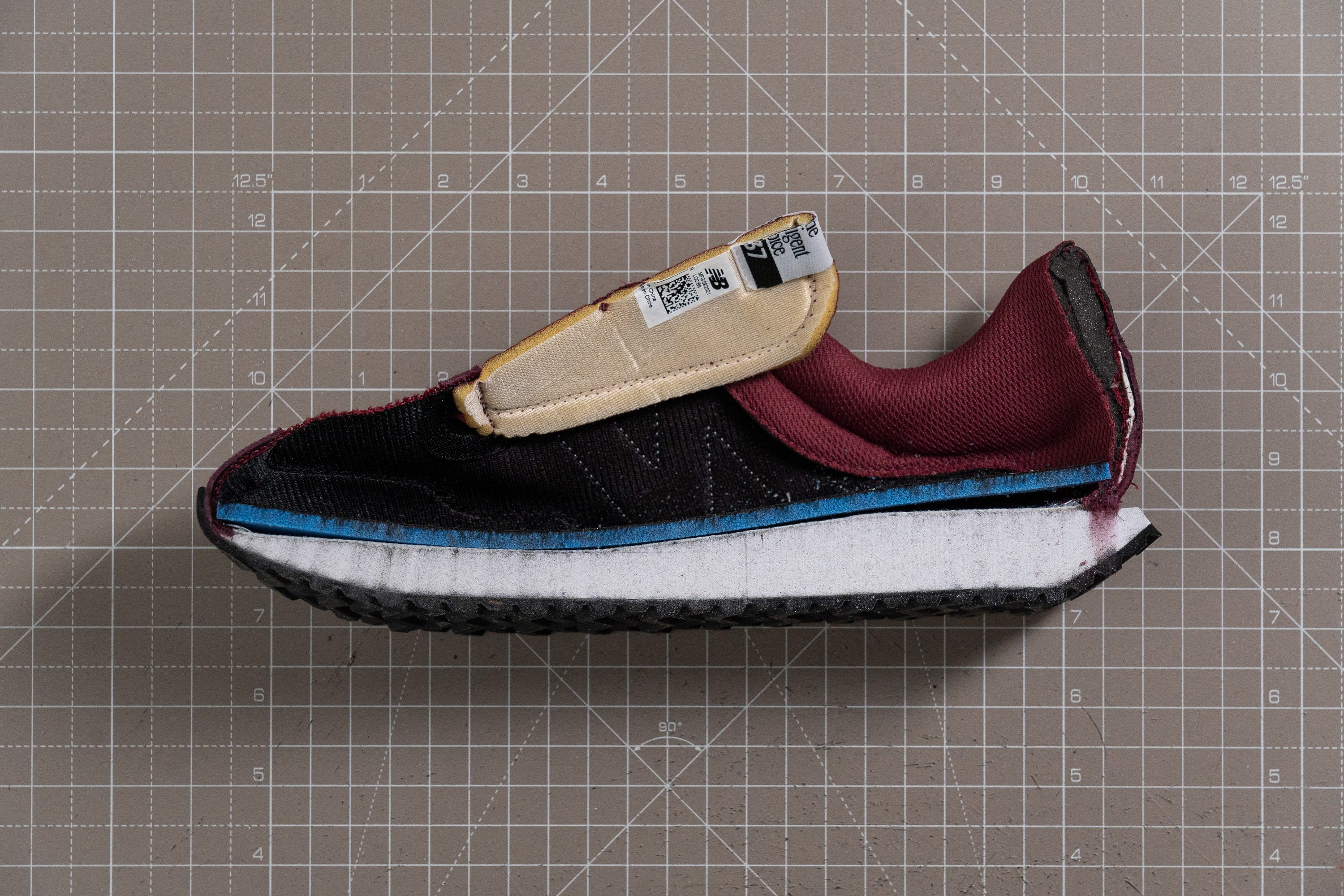
To keep things clear, there's no such thing as a 'good drop' or a 'bad drop' as it all depends on your personal preferences.
Some people like it when their heel is slightly elevated, and some others get stressed about the possibility of their feet sliding down inside of the shoe because of the height difference at the front and at the back.
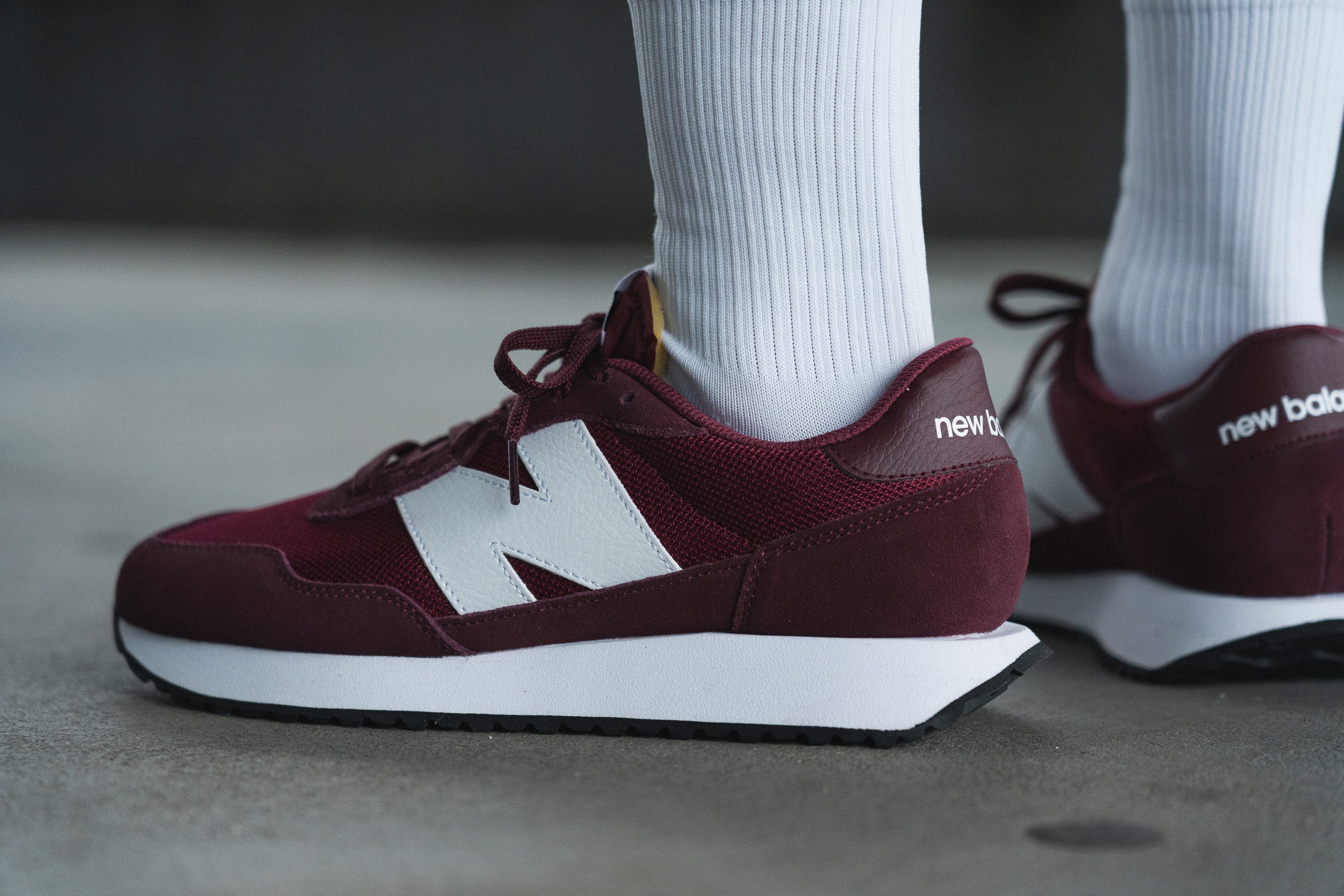
These cuties felt natural from day 1, which is something that we appreciate a lot! Like, no one wants a lifestyle shoe to walk around in that's difficult to walk in, right?
Note: If you want to know more about the heel-to-toe drop, check out our ultimate guide.
| 237 | 10.0 mm |
| Average | 11.2 mm |
Midsole softness
Now, now, the star of the show... the 237's midsole!

At 42.5 HA, not only our durometer can tell you it's way less soft than average... so can our feet! We were pretty surprised, so we decided to compare it with the general results of its category, which is trainers. It's 28% firmer than what we usually read in our lab!
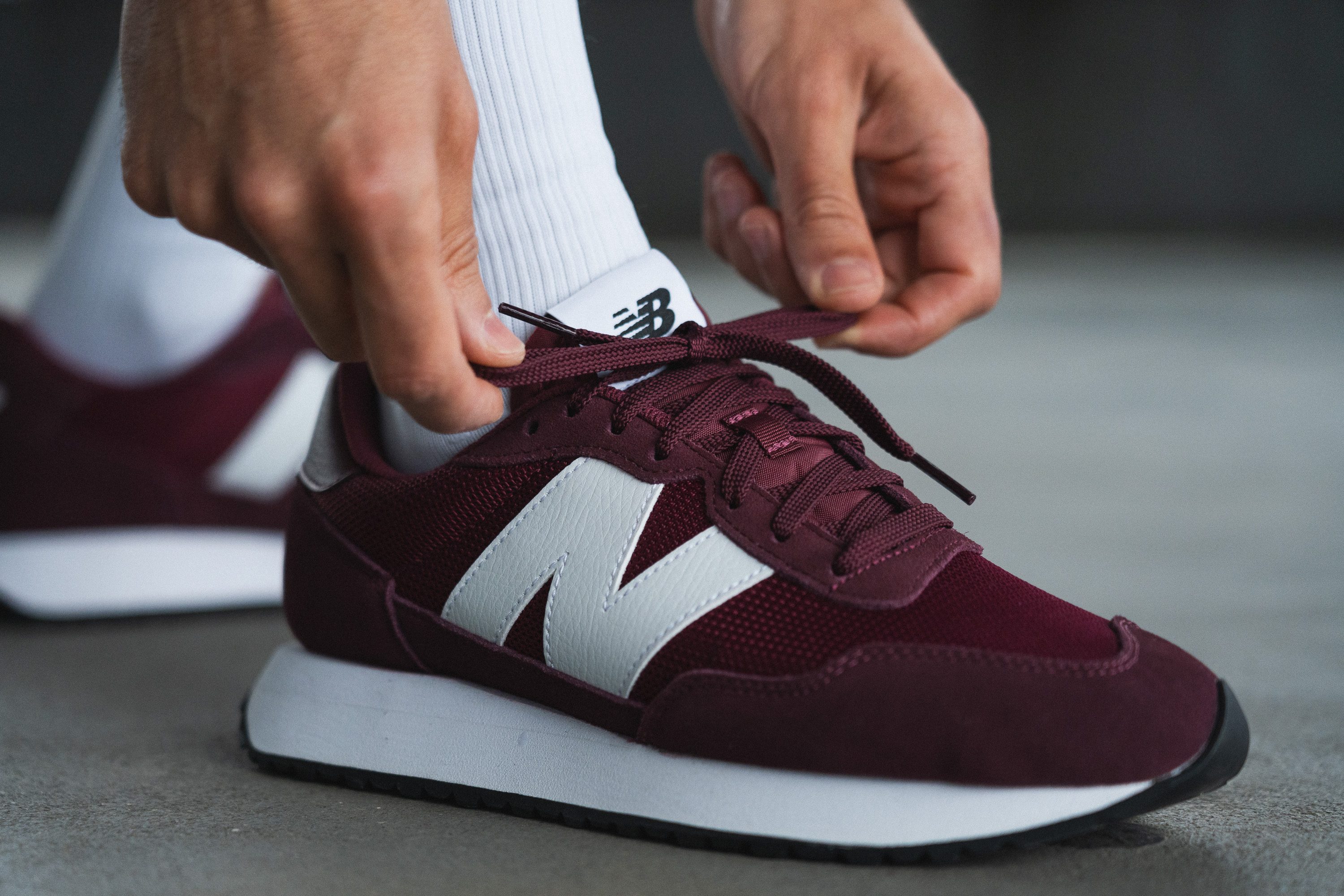
But, please, don't misunderstand us. This does, by no means, mean that the shoe is uncomfortable! Its midsole is just on the firmer side, that's all!
If you're used to extra plush midsoles and a cloud-like ride, like the ones you can find in the New Balance 9060 (19.4 HA), then it's gonna feel different, that's for sure! But it's not necessarily bad, though. Just... uncommon.
| 237 | 42.5 HA |
| Average | 28.6 HA |
Size and fit
Size
New Balance 237 fits true to size (117 votes).
Internal length
| 237 | 266.8 mm |
| Average | 272.3 mm |
Width / Fit
The NB 237 is most likely built on the exact same last as most other New Balance trainers. Our medium-width feet experienced no discomfort or pressure.
To back up our impression with measurements, we created a gel mould of the shoe's interiors and measured its dimensions with a calliper. The mould's widest part (the metatarsal area) returned 91.0 mm, which falls right into the D medium range.

| 237 | 91.0 mm |
| Average | 92.5 mm |
Toebox width
The 237 doesn't have a major taper angle either. Showing 70.2 mm of width near the big toe, it is on par with the average.

| 237 | 70.2 mm |
| Average | 68.9 mm |
Toebox height
This NB kick aso provides enough vertical space for the toes to feel free. We measured its toebox height at a standard 28.5 mm.

| 237 | 28.5 mm |
| Average | 27.8 mm |
Traction / Grip
With its running shoe past, we would say this New Balance's traction is just average.
This means that it provided enough grip for most occasions, just nothing special. As long as we didn't try to conquer damp grass, ice, or any other challenging surface, we were pretty much fine.
Wait, actually, forget about wet floors in general. Those were a nightmare.

What we really liked about it is that this shoe has a full-length outsole, which means more durability (hooray!). But the zig-zag pattern doesn't have any prominent lugs, which is already telling us... things might get slippery. If you're looking for a pair with a similar vibe but full of round lugs that will bite anything and everything, just change a number and try the New Balance 327.
Traction test
The NB 237 is one of very few trainers in our catalogue that provide exceptional grip on dry, wet, and even polished surfaces. While it's not 100% slip-resistant, this shoe's outsole returned some of the highest friction coefficients in our lab - 0.58! Its tacky rubber and wavy trad pattern proved to be a winning combo.
| 237 | 0.58 |
| Average | 0.43 |
Outsole design
The 237 features a full-length rubber outsole that screams surefootedness and, surprisingly, doesn't affect the shoe's flexibility. It also relies on a simple undulating tread pattern which may look unassuming but gets the job done brilliantly.

Flexibility / Stiffness
With its above-average forefoot stack and exceptionally firm midsole, we never expected forefoot flexibility in the NB 237. And even though it's not as bendy as those Sambas, it's not hopelessly stiff either.
According to our flex tester, the shoe required a moderate amount of force (13.3N) to bend by 30 degrees. That's a typical stiffness for a lifestyle sneaker that doesn't mess with smooth heel-to-toe transitions.
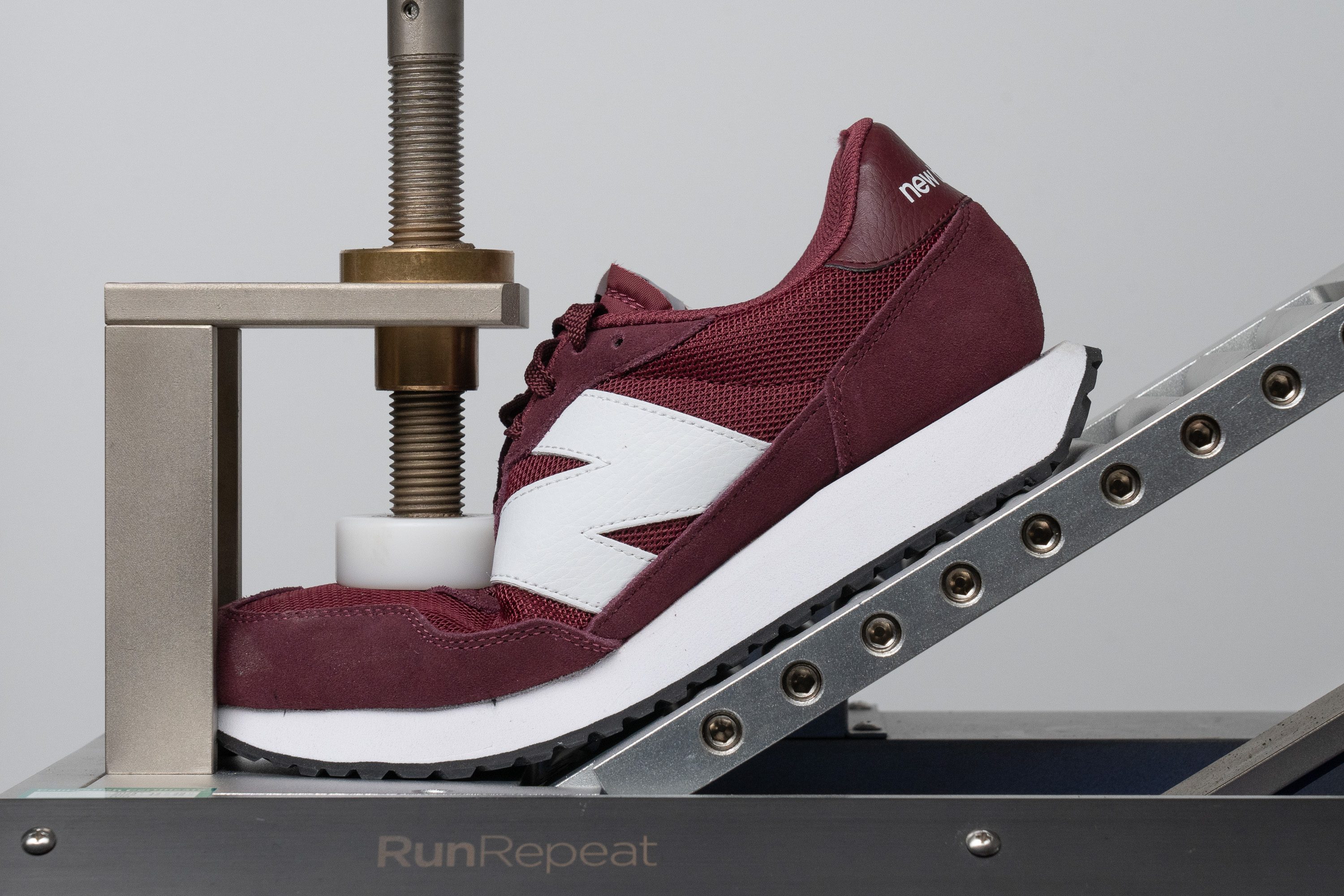
| 237 | 13.3N |
| Average | 13.3N |
Weight
Ding, ding, ding! We've got a winner! And it's... us.
We're not gonna wait any longer, so let us tell you straight away. Do you remember we said the thinner outsole of this shoe might be a witty gambit-style move from NB to keep it lightweight? Well, we were right!
So that makes you the winner as well. If you go and grab a pair, that is.

At 11.3 oz (319.0g), this shoe is incredibly light! And our feet agreed completely.
During our wear tests, we could enjoy the mix of breathability and lightness in our every step. This made us want to keep walking, as our feet had a very healthy environment that promoted longer strolls.

Being a whole 24% lighter than the average sneaker that we've tested in our lab is no joke. And we couldn't be happier!
Just double-check your feet before you go to bed, you might forget to even take these kicks off!
| 237 | 11.3 oz (319g) |
| Average | 13.8 oz (390g) |
Breathability
When we analyse shoes, we always get the party started with some smoke in our lab. Yeah, smoke, you read it right! But not with one of those big machines that you can find in some popular night bars. What we use is a small device to fill the interior of each pair with smoke, and then we sit and see how much of it the upper material lets out.
If this was a chimney contest, the 237 would have the upper hand! As you can see on the right of the video, the Reebok Classic Leather is not one of the most breathable shoes in our catalogue. On the contrary, our NB pal lets the air go through with no problems, and it does it with a constant and thick pillar. Kudos to you, 237!
Consequently, we've given it a well-deserved 4/5 in our breathability test. So... what's its upper doing so right for the shoe to have such a great score? Let's ask our microscope!
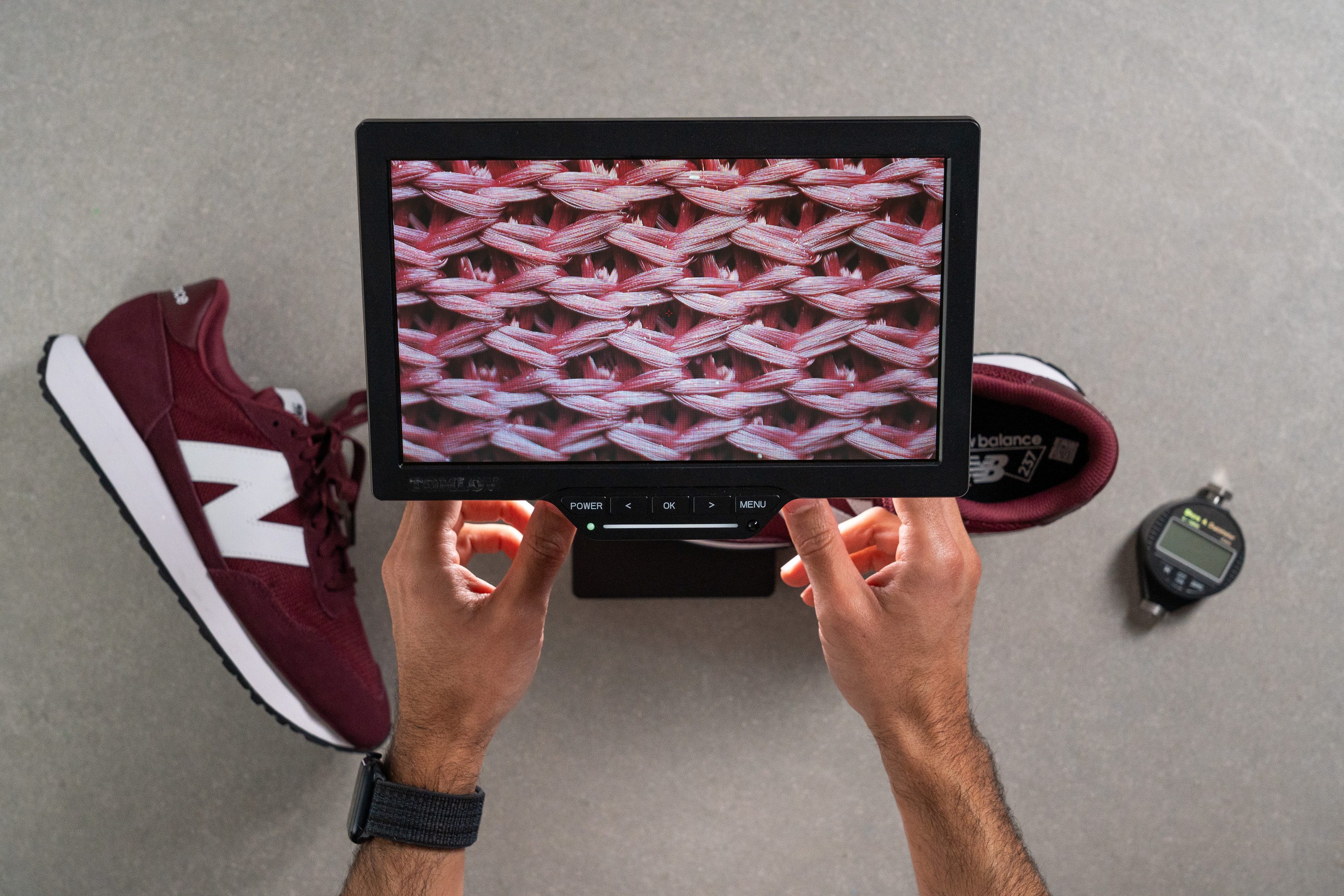
Big ventilation gaps. That's it!
Wait, wait... is that a second layer we see? Close-up. please!

Heck yeah, it is! We LOVED the design of this pair. As you can see, both layers have extra big gaps to let the air come in and out and, at the same time, them being two should give the shoe some extra durability... right?
Look at all the light shining through the mesh! This means this pair is going to be a wonderful mate for summer walks. And trust us, it was!
| 237 | 4 |
| Average | 3 |
Stability
Lateral stability test
As you can see in the video below, it's not the best shoe to keep your feet in place.
Our standard-size feet moved quite a bit, but not enough for us to say that it's dangerous to walk around town with this pair! It just doesn't have the most supportive structure, that's all.
It focuses on other areas, like being lightweight, for example. If its upper materials were more rigid and thicker, the shoe might have been not only heavier, but most likely more uncomfortable too.
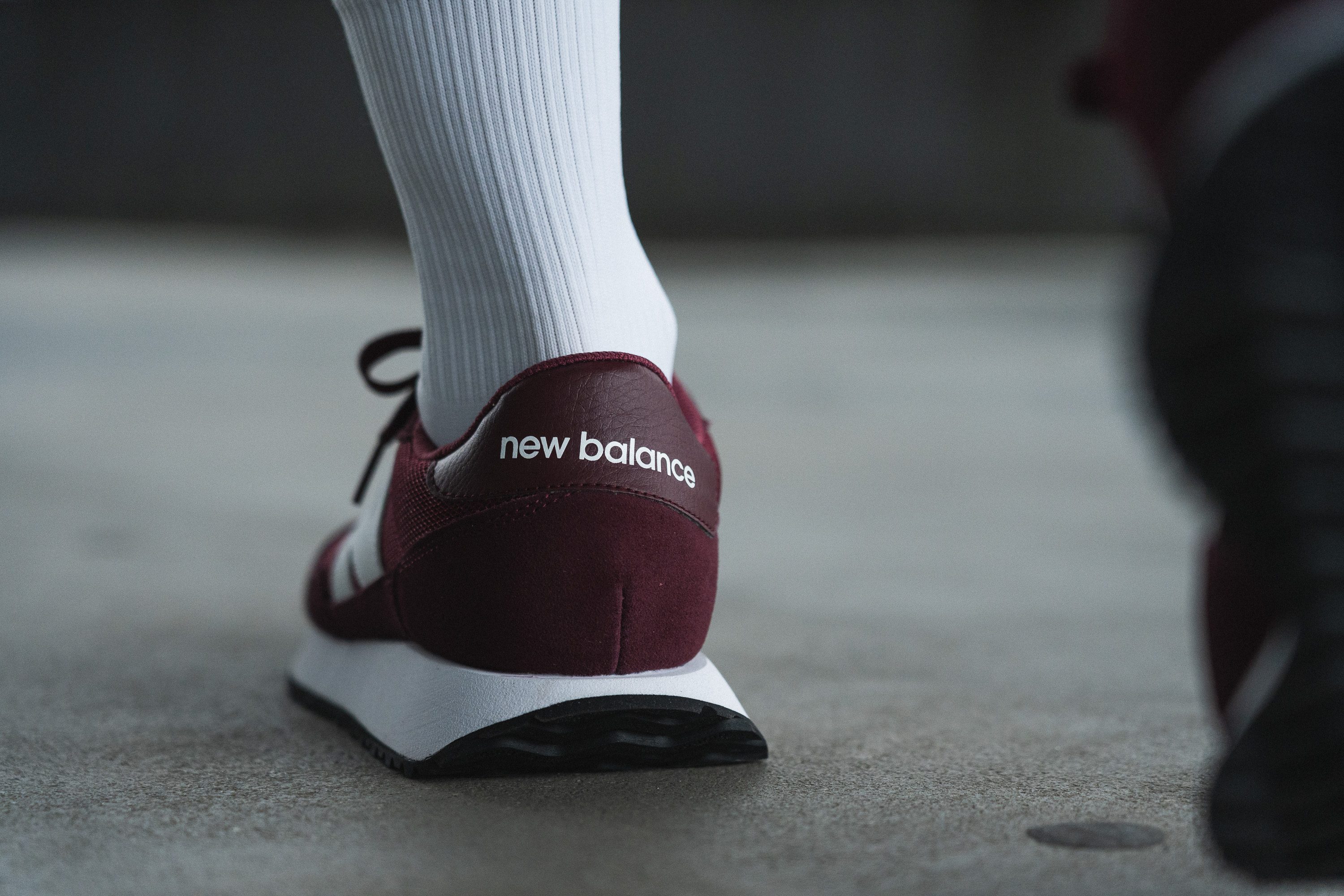
You can see it clearly in the picture.. the design of this model doesn't exactly scream supportiveness. Just by looking at it, you might even wonder if it even makes your feet pronate! Well, we wouldn't go as far, but it's true that the pronators among our testers didn't like this model at all.
They'd argue that their feet would move and even roll a bit when they were just walking around town. We found this quite dangerous, so please stay away from them if you're a pronator! Just have a look at our guide with the best New Balance walking shoes to find the one that works best for you.
We recommend the New Balance 1906R, as its lateral support helps people with flat feet and overpronation.
Torsional rigidity
Now, now, this is quite interesting...
In the video, you can see that it's not that easy to bend the shoe. It scored a wonderful 4/5, which is the closest to the highest torsional rigidity a shoe can have. This should be good news for people with foot conditions, and definitely bad news for natural-ride lovers!
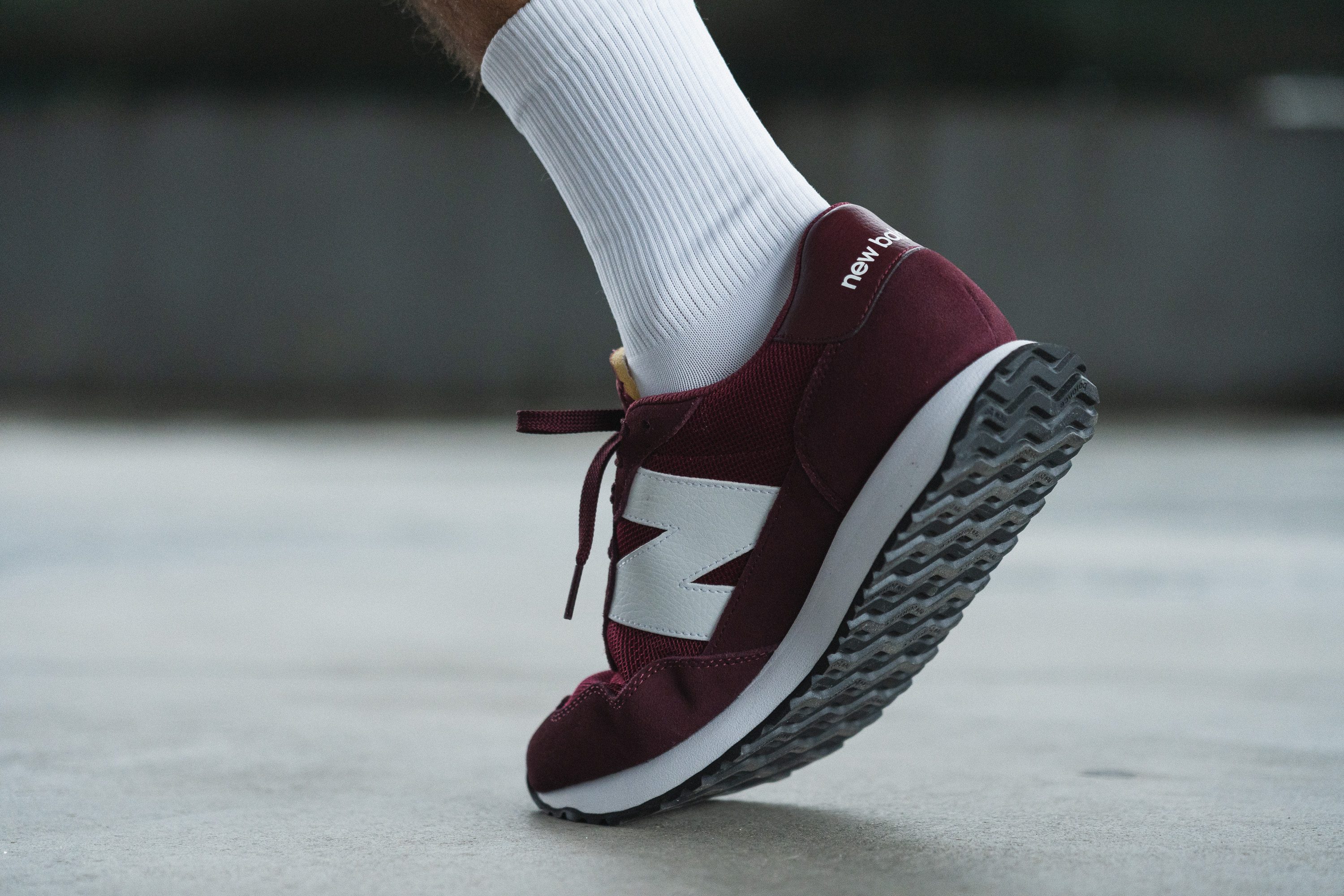
But... when we walked around town, we didn't feel that supported. It's true that the shoe didn't really move along our feet, but its structure was also not rigid enough to keep our feet in place. And we know why: the mix of thin and breathable materials in the upper, making that part of the shoe not supportive, with a very rigid midsole, that makes it hard for it to bend when you're walking.

Also... the shoe bends in an ugly way in the toebox, which is something that we didn't really like. It has nothing to do with comfort, this is purely aesthetics, but... we just had to tell you.
| 237 | 4 |
| Average | 3.6 |
Heel counter stiffness
The heel is quite pliable, and we loved that.
It saved us from blisters, hot spots, and uncomfortable rubs. It also added some extra comfort to the whole shoe, which was very much appreciated by our feet.

| 237 | 3 |
| Average | 3.2 |
Midsole width - forefoot
Even though this shoe's structure is not very supportive in general, it has a wide midsole that will make your feet have the happiest landings.
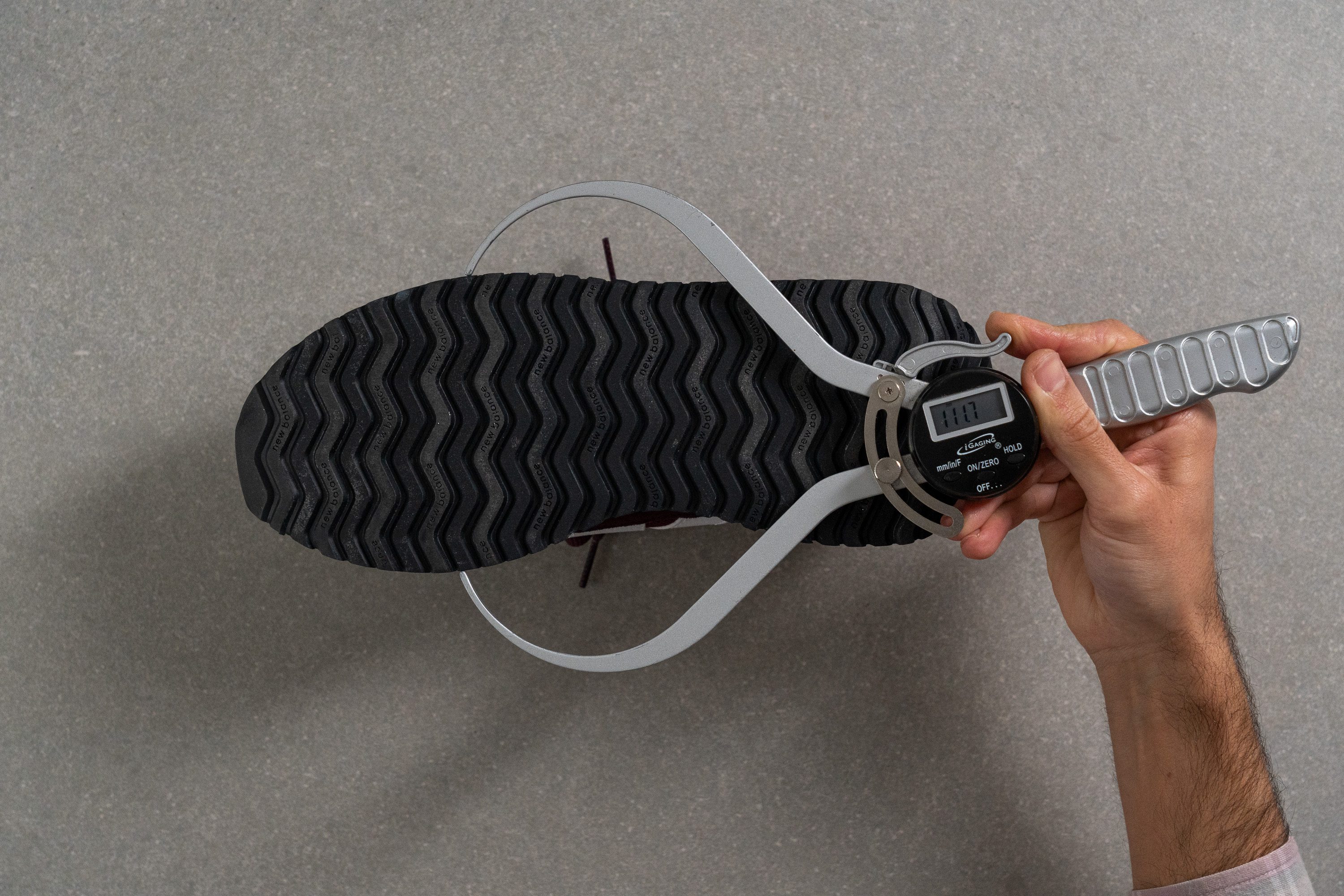
At 111.7 mm, this pair is slightly wider than average in the forefoot. And we loved every bit of it!
| 237 | 111.7 mm |
| Average | 108.9 mm |
Midsole width - heel
When our calliper returned 101.7 mm, we just couldn't believe our eyes. Evidence? Right here, official!
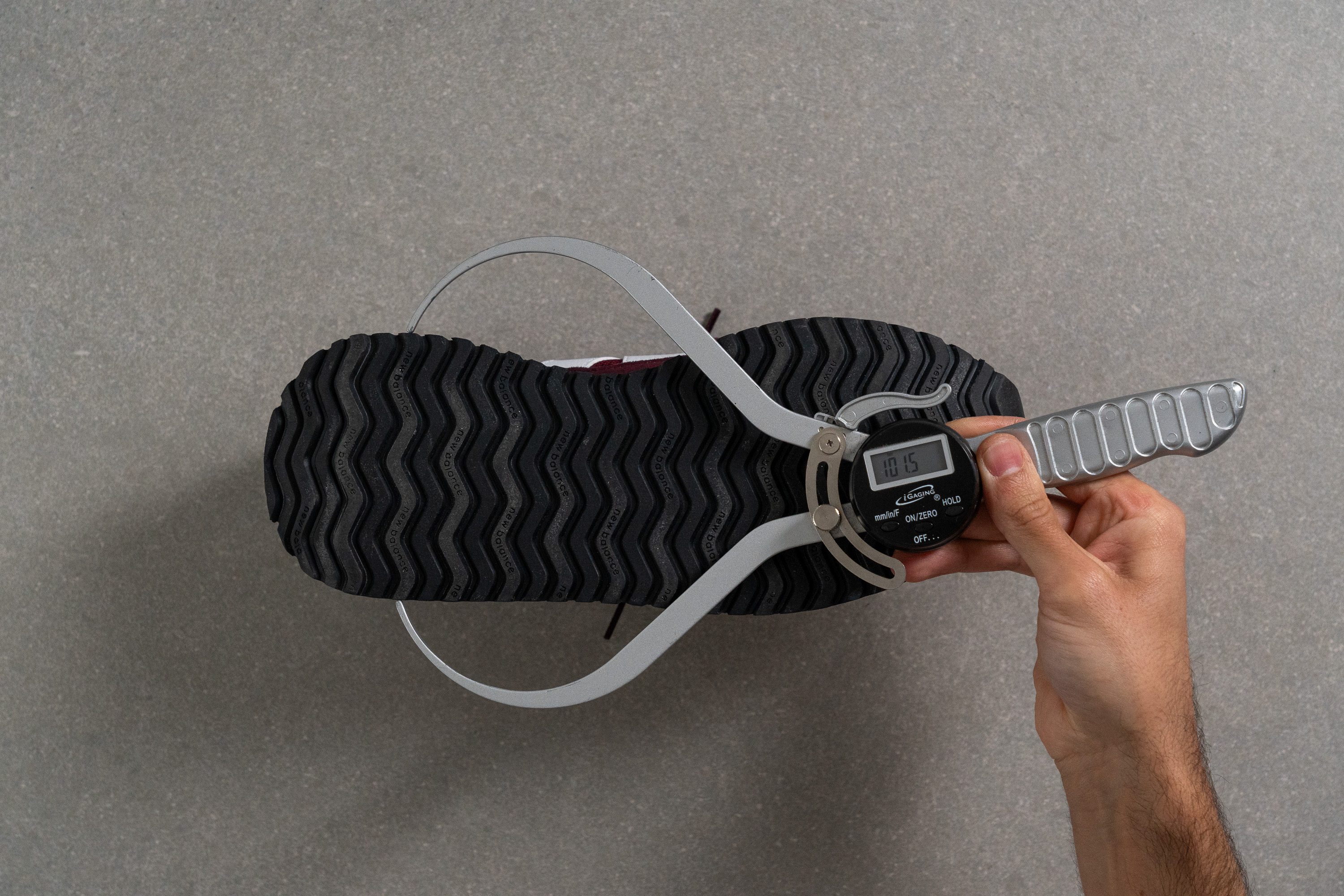
We know. WE. KNOW. It's massive! If we go down to percentages, the midsole width in the heel of this shoe is a whole 18% wider than average. Trust us, that really is a lot!
While this might sound fantastic for people who like roomy shoes, individuals with narrow feet might find it slightly inconvenient. The testers among us with narrow feet said they had to tie this pair extra tight, using the top eyelet, to keep a snug fit. For the ones with standard-sized feet, this meant some enjoyable extra space.
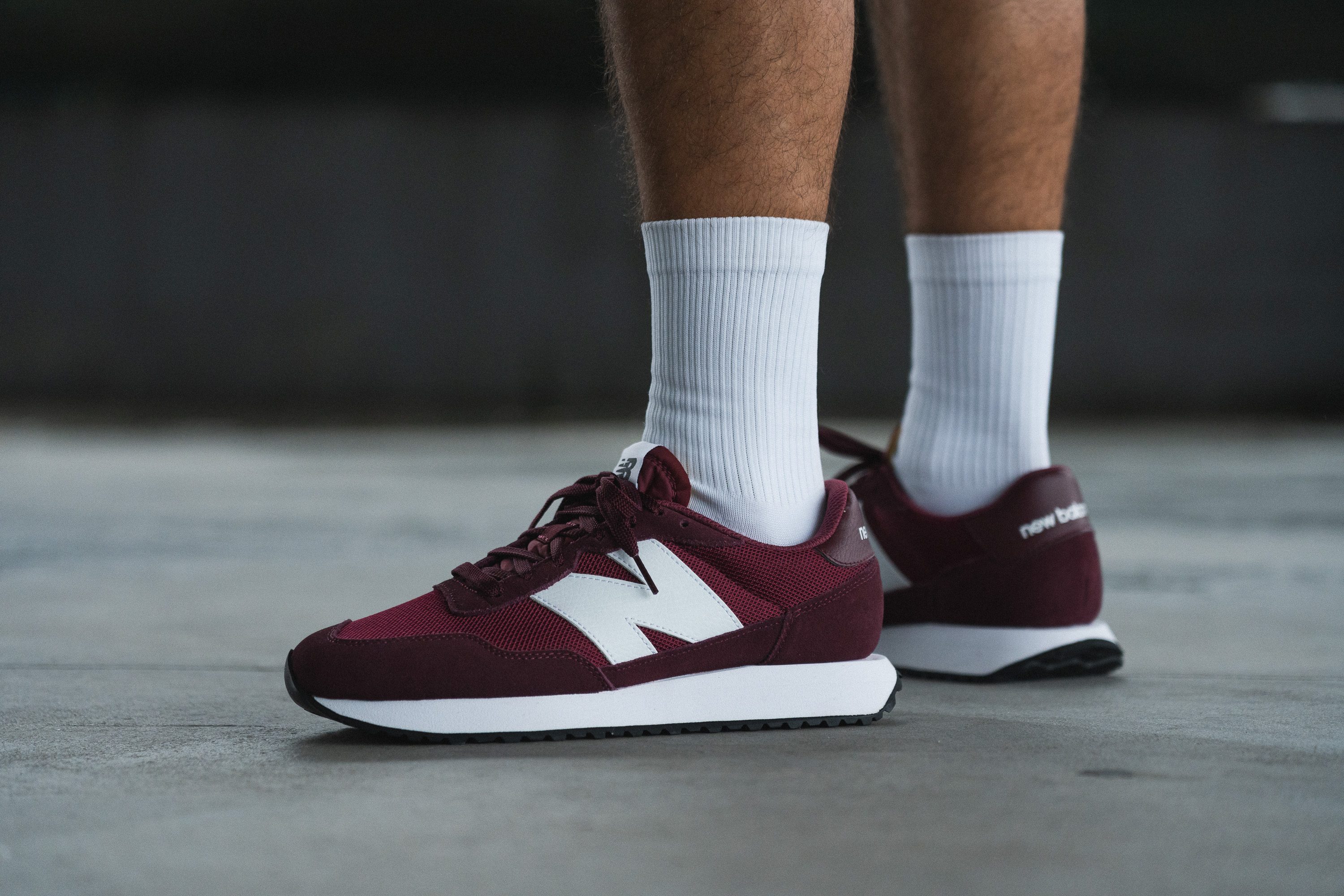
| 237 | 101.7 mm |
| Average | 84.0 mm |
Durability
Leather/Suede quality
New Balance is a very well-known brand, and even though this is not its most expensive pair, we wanted to know if it was designed using authentic materials.
Torch in our right hand. NB 237 in our left hand. And let's keep the party on fire.
As the suede material doesn't catch fire, we can confidently say it's authentic/real.
Oh, but that leather part at the top of the heel? Fire, baby. It's clearly fake/synthetic.
| 237 | Real suede |
Toebox durability
We could say breathability and durability are sworn enemies by now. It's common for shoes to use very tough but toasty materials, or quite flimsy and airy ones. That's why we couldn't keep our mouths closed when we saw the results of our toebox durability test.
The suede part at the toebox fought our Dremel courageously. And it won! With a fantastic 4/5 in our toebox durability test, we're incredibly proud of this pair.
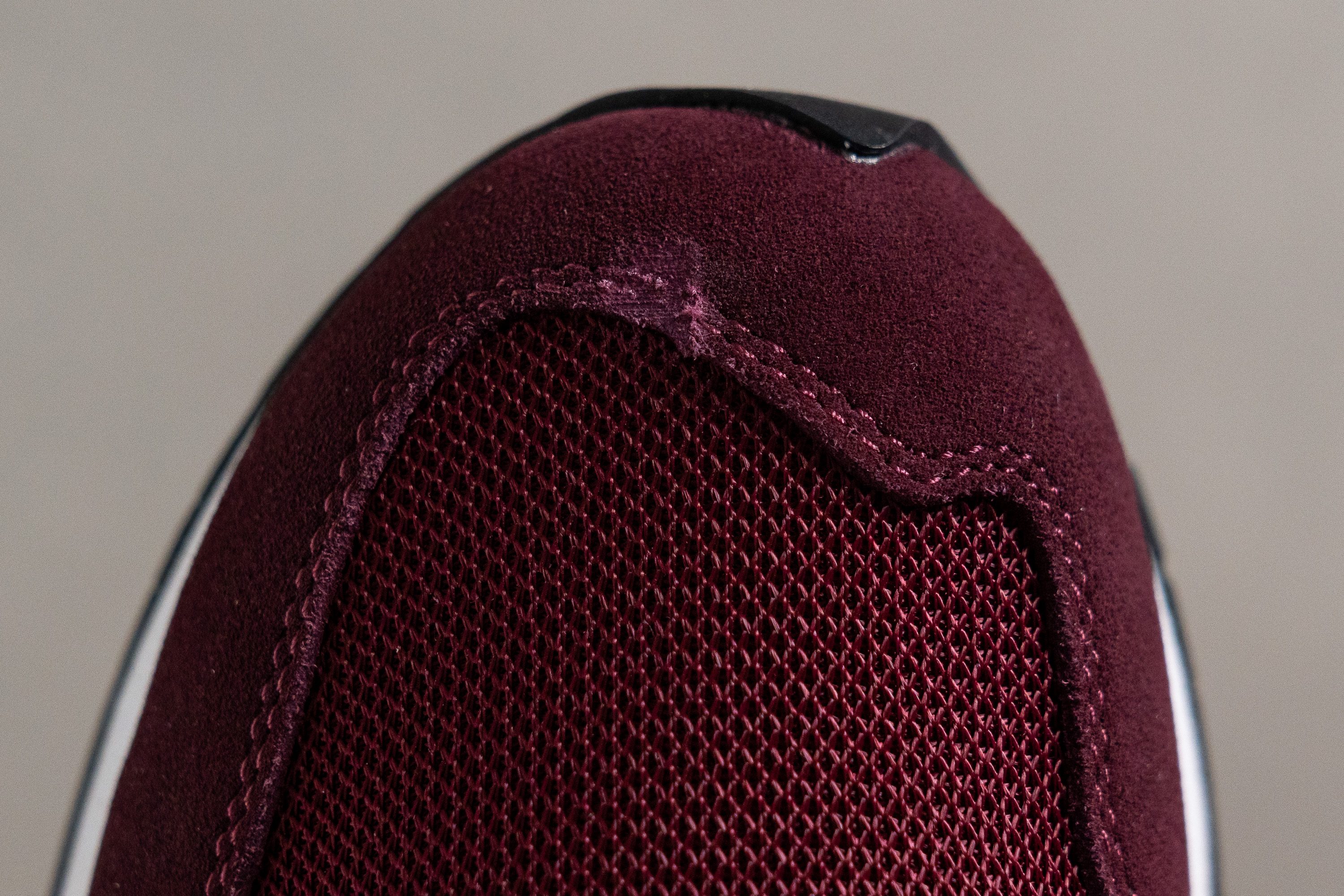
As you can see in the picture, the damage is minimal! The suede overlayer surrounds the forefoot shamelessly, and it protects the mesh way more than other suede-mesh combo models.
We thought this was a really smart and stylish idea, as the combination looks cool and is also functional.
Way to go, New Balance!
| 237 | 4 |
| Average | 3.7 |
Heel padding durability
Well... not everything about this shoe could be pretty much perfect, right?
With almost tears in our eyes, we stood and watched our Dremel obliterate the 237's heel padding. Bye-bye!
With red threads flying around and getting tangled in our tool as if they were cotton candy, we could only give this shoe a 1 out of 5 on our heel padding durability test. That's the lowest score, but look at this and tell us it deserves higher:
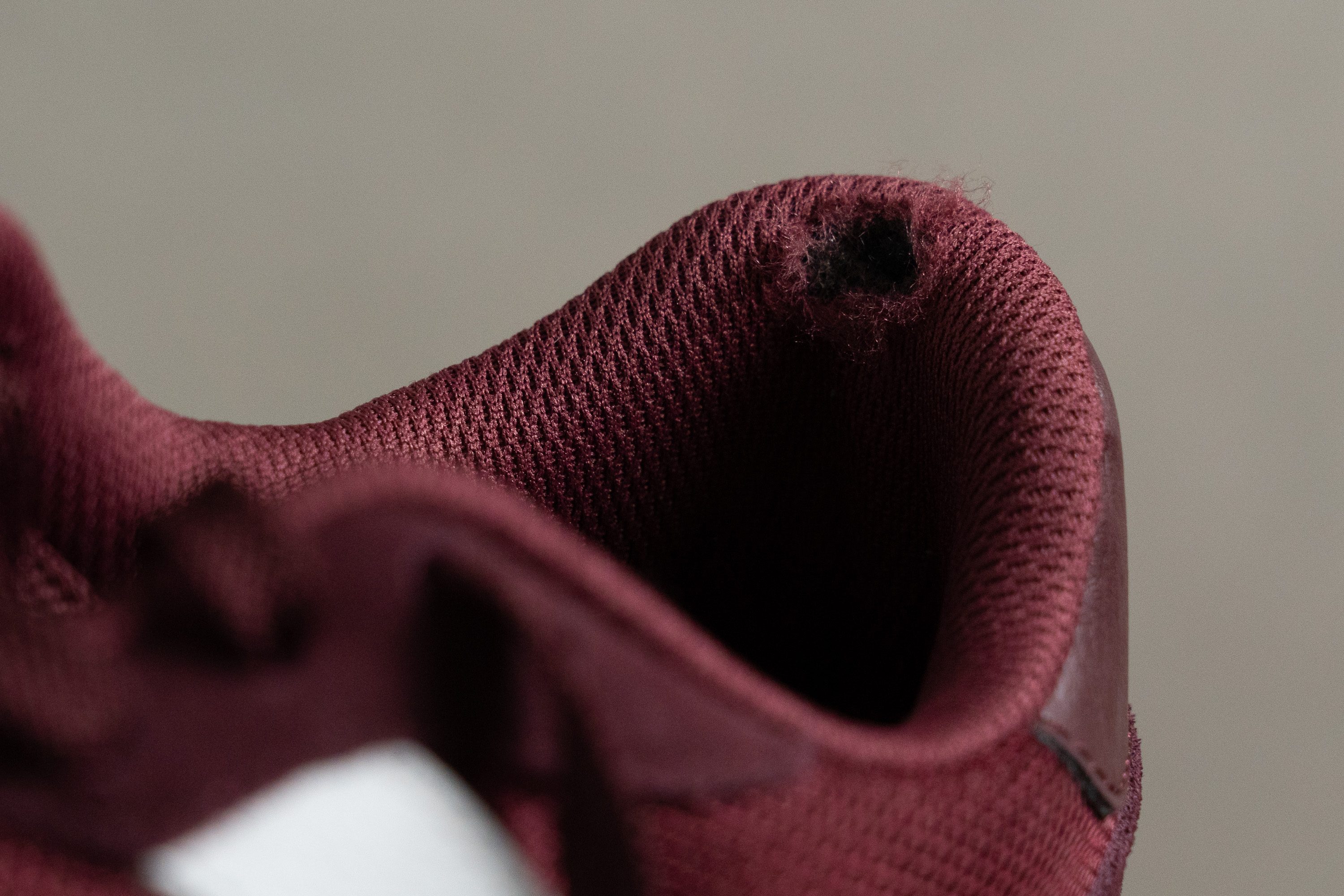
With that hole? Nuh-uh, it doesn't. It's true that this part is one of the most fragile ones, especially in trainers. But such a low score means it won't last long... and that sucks!
| 237 | 1 |
| Average | 3.2 |
Outsole hardness
We grabbed our durometer and pressed it against this pair's sole. At 86.0 HC, it's pretty much average, which means it offers a fantastic mix of grip and durability.
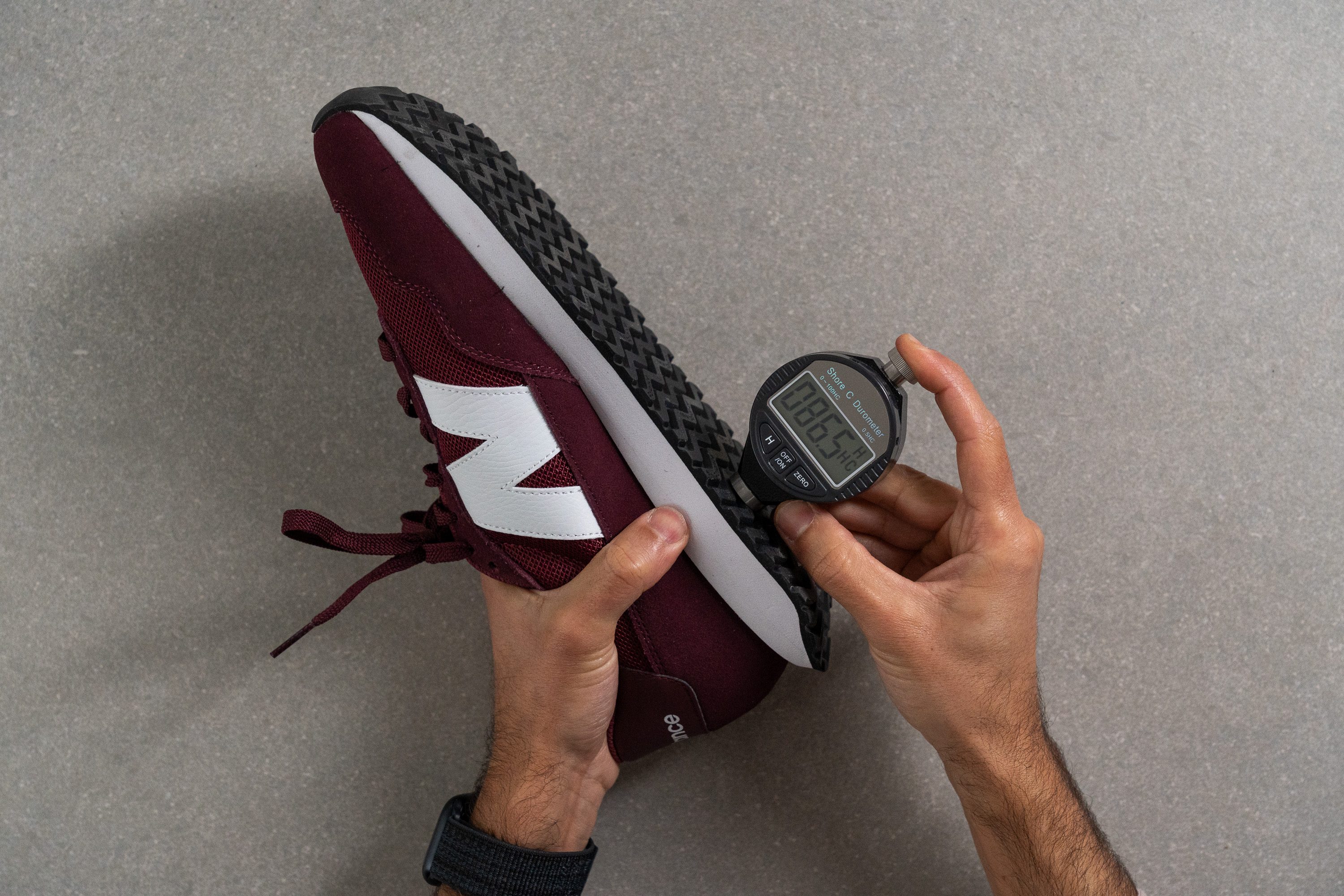
We're so excited to tell you about those two features, but we'll have to wait! Keep reading and don't miss out!
| 237 | 86.0 HC |
| Average | 85.7 HC |
Outsole durability
So..., what was that again? Tough upper, weak heel, and... what about the outsole?
We took a deep breath and grabbed our Dremel. It was, once again, show time.
Alright, alright, let's all wipe our sweat! After this 22-second-long drilling session, the results were fantastic! With a dent that's only 0.8 mm deep, we felt like hugging our tread gauge after such good news.

Can you spot it? It's just a little bit bigger than a scratch!
We were incredibly happy about this, as it means that this model is slightly more durable than most trainers, at least regarding its outsole.
Nice one, 237! Gotta keep that running heritage... well, running.
| 237 | 0.8 mm |
| Average | 1.1 mm |
Outsole thickness
So, now we know the rubber is tough, but... is there a thick layer?
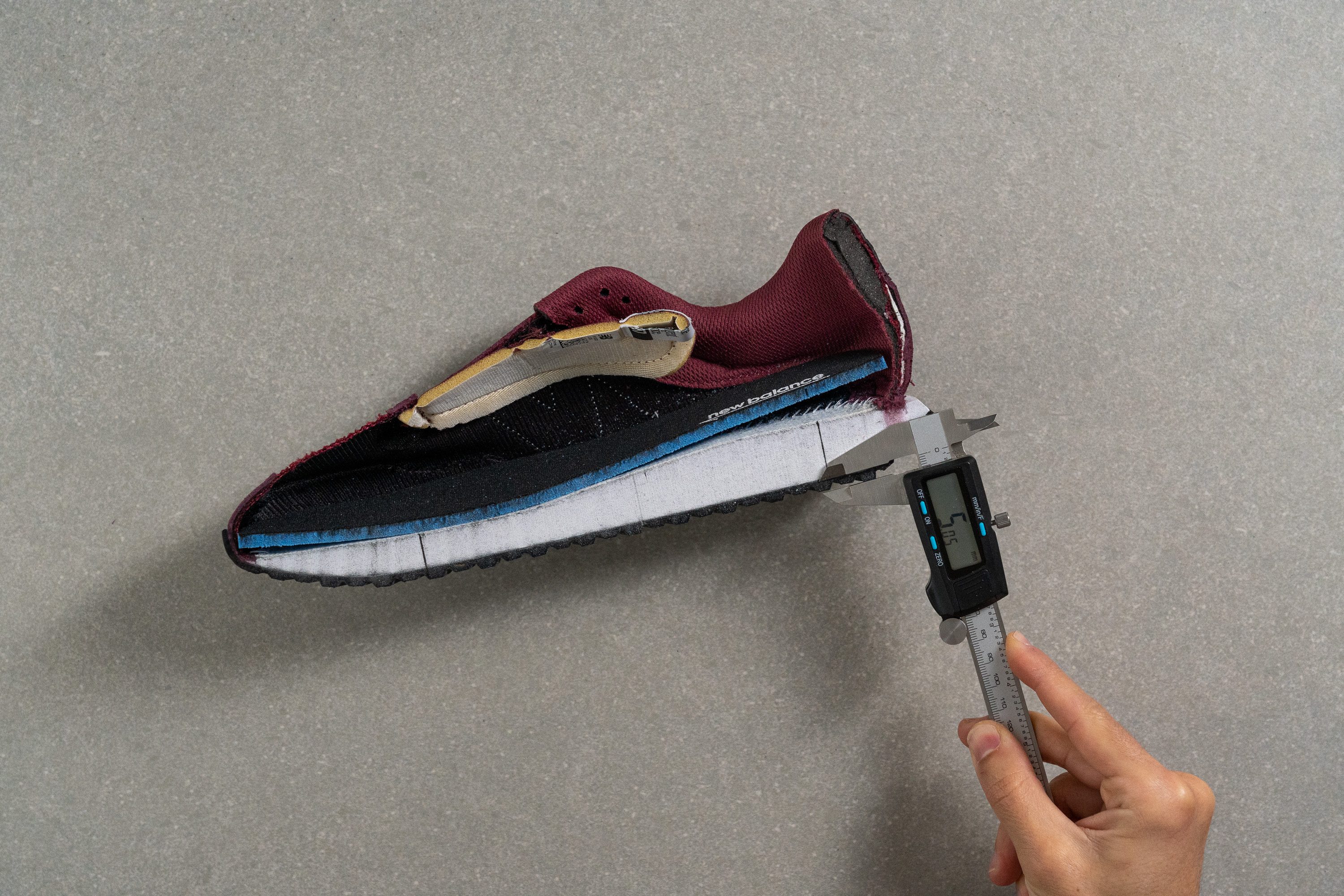
Well, not really! At 5,1 mm, the outsole is thinner than average. But taking into account the great results it got in our durability test fighting the Dremel, we weren't really worried.
Also, as the rubber used in the bottom of the shoe is quite resistant, we believe the brand decided to use a thinner layer to keep the shoe's weight down. Right, NB?
| 237 | 5.1 mm |
| Average | 5.3 mm |
Misc
Insole thickness
As a brand that knows pretty much everything about arch support, New Balance decided to keep it simple regarding the insole.
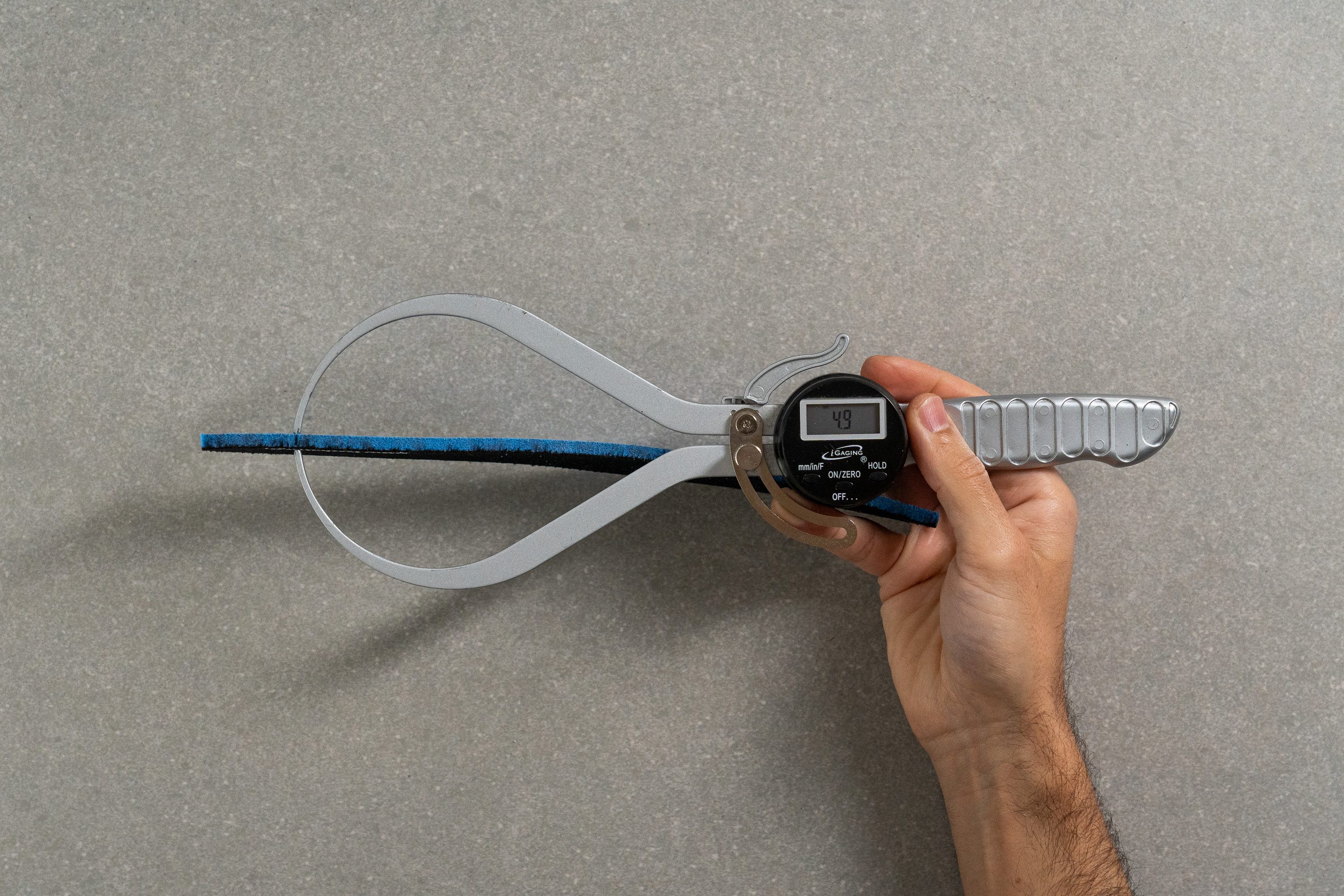
At 4.9 mm, it's slightly thinner than average. With such a firm midsole, we did think NB would go for a plushier and thicker insole for the 237. But that would mess with the "let's keep the weight down for this summer shoe" goal.
A little bit more fun in here wouldn't have hurt, though. But we still found the shoe comfortable.
| 237 | 4.9 mm |
| Average | 5.1 mm |
Removable insole
Another really nice detail is that this NB has a removable insole.
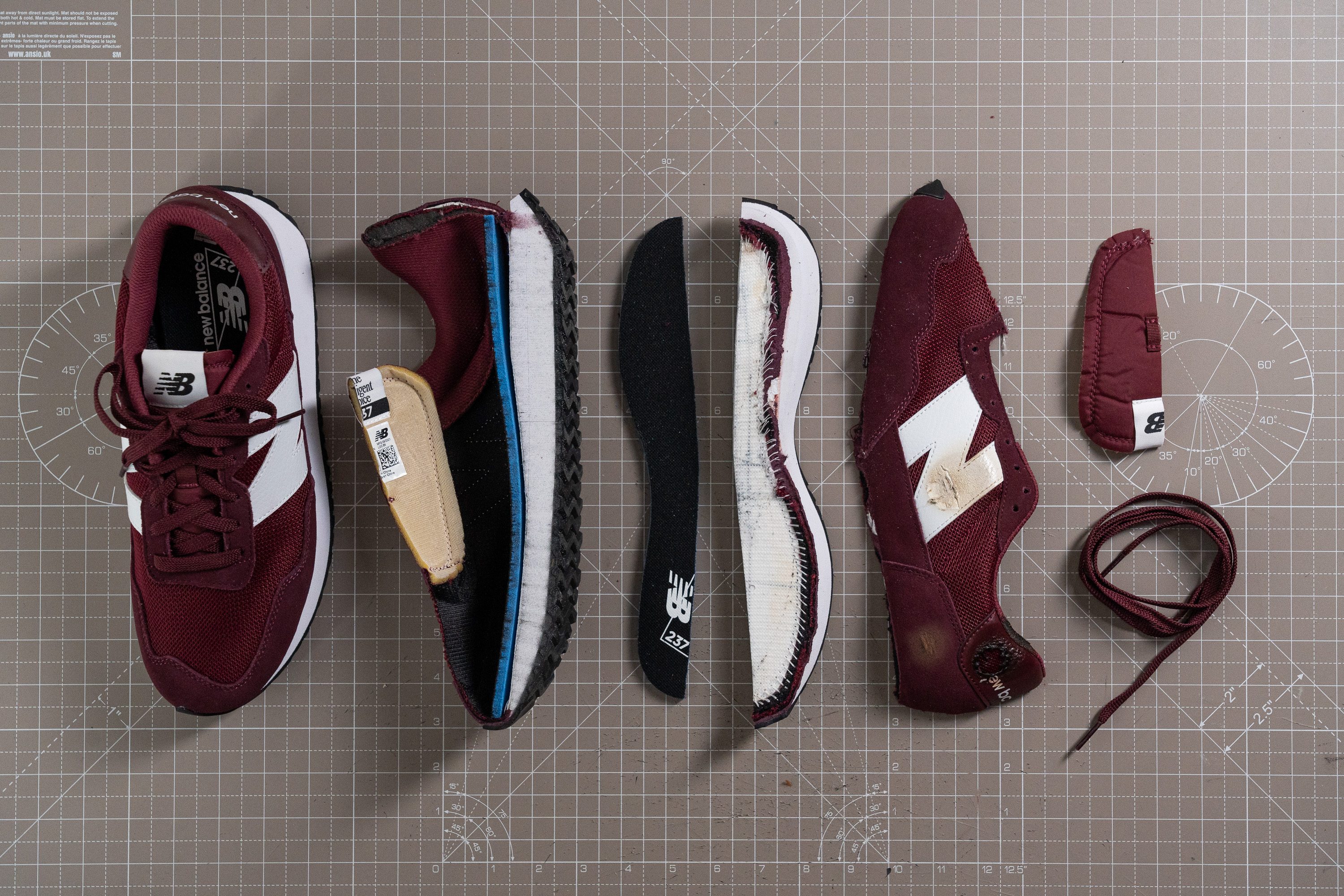
You can go for your own orthotics if needed, or if you want some more plushness to battle the stiffness of the midsole.
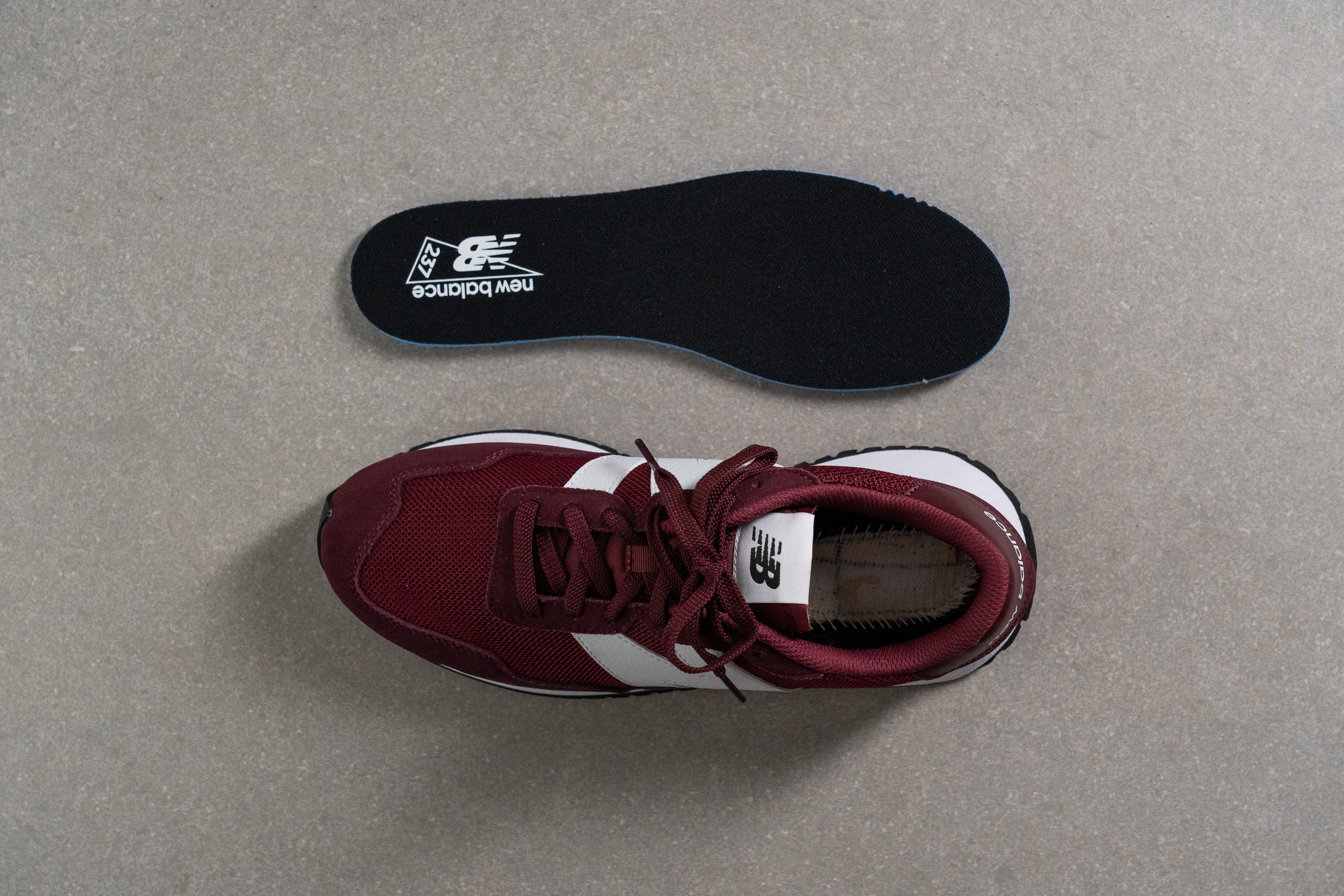
| 237 | Yes |
Reflective elements
No reflective elements here!
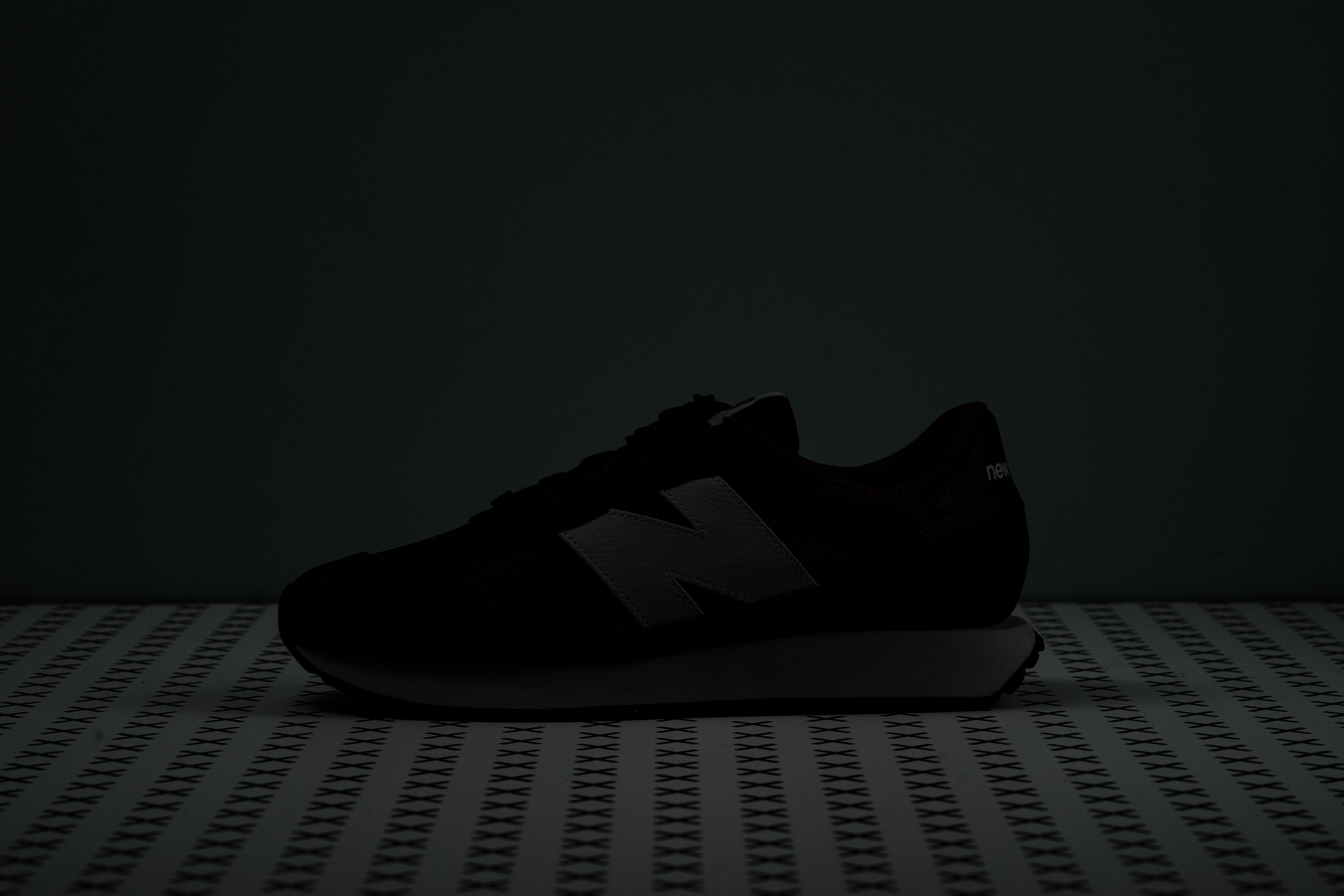
By looking at the shoe design, we were thinking it would've been cool to make the massive N reflective, right? Maybe next time, New Balance!
| 237 | No |
Tongue padding
Many brands go for a non-gusseted tongue to keep the weight down, and the padding just follows this same logic.
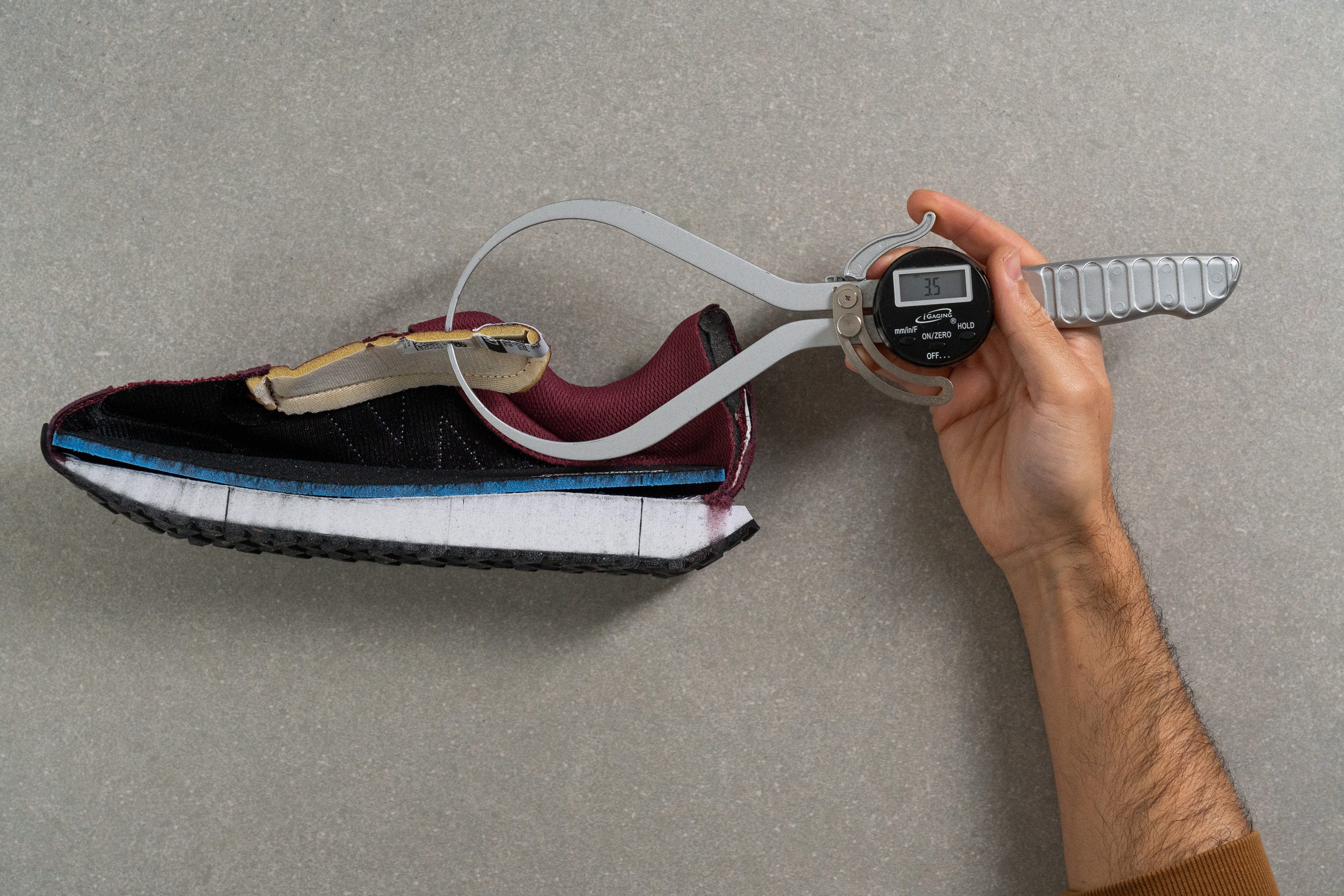
At 3.5 mm, this NB's tongue is way thinner than average. But the whole shoe is pretty minimalistic in this sense, just check this video out.
The top of the collar is the only part of the shoe where we can actually see some soft padding. The rest keeps it down: lightweight, simple, and breathable. And we can't complain!
PS: We LOVED the retro tag at the top of the tongue! But its exposed foam and unfinished touch might not be for everyone, though. Keep it in mind before you buy it!
| 237 | 3.5 mm |
| Average | 9.6 mm |
Tongue: gusset type
As you can see, the tongue doesn't have any gussets (which are attachments) on the sides.

Unfortunately, for us this resulted in the tongue moving to the side a little bit, but nothing uncomfortable or annoying. If you use the small loop it has in the middle and tighten the laces, this problem will vanish into thin air.
| 237 | None |
Heel tab
This model doesn't have a heel tab, but we believe it just doesn't match its vibe. Also, as its tongue is non-gusseted, the opening is wide enough and we didn't have any trouble putting the 237 on.
Not many New Balance shoes have one, though. The brand usually goes for a simple design by just putting its name. Which, in this case, is slightly angled as you can see. No, no, it's not a manufacturing defect. It's just... well, New Balance!
Truth be told, we liked this risky detail on a retro shoe. It pairs up with the huge N in the quarter area. It just makes a simple design different, and the logo stands out in the best way possible. Cool feet and cool design, right NB?
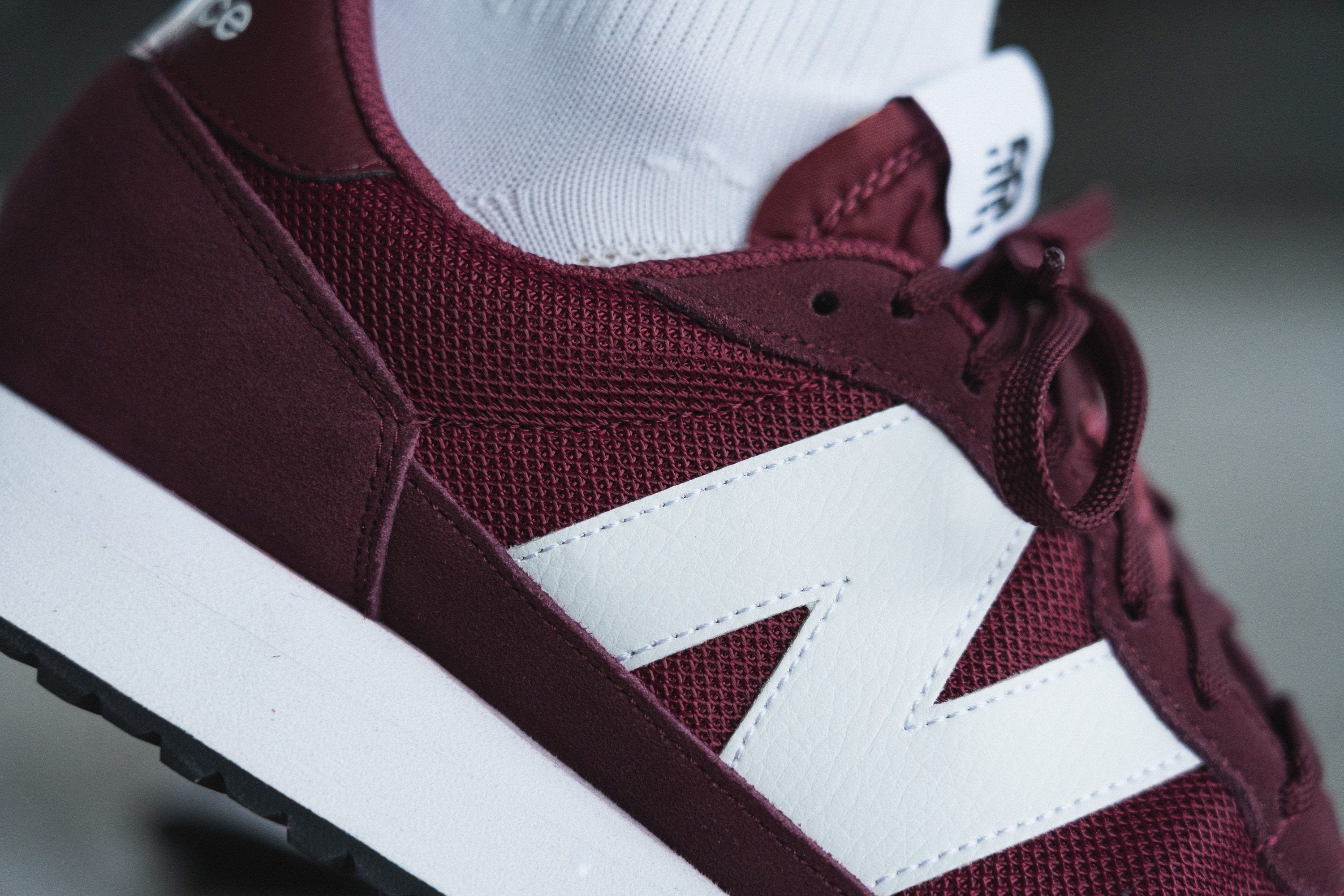
| 237 | None |

